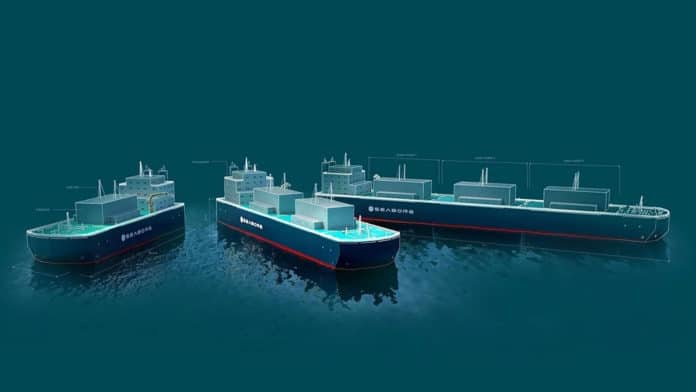A Danish nuclear company Seaborg Technologies is developing a new type of 200-megawatt mini nuclear reactor to be installed on modular power barges. The Compact Molten Salt Reactors (CMSR) recently passed a feasibility test by the American Bureau of Shipping (ABS), which is an important milestone towards our ambitious target to deploy the first commercial power barge by 2025.
Seaborg’s Compact Molten Salt Reactor is designed to be installed on modular power barges, providing clean and affordable electricity worldwide. The power barge design is enabling configurations with two, four, six, or eight CMSRs delivering up to 800 MW-electric or 2000 MW-thermal. The first power barges will have two reactors installed, delivering 2 x 100 MW-electric for the 24-year lifetime of the power barge. And over that lifetime, they will offset a minimum of 33,600,000 tons of CO2 compared to an equivalent coal power plant.
Seaborg will deliver clean and affordable energy in the form of floating power barges, with a market focus on growth regions such as South East Asia. The floating nuclear power barges will produce clean electricity for electric grids or hydrogen production. Alternatively, the power barge can deliver high-temperature steam, which can be used for process applications.
“The maritime approach reduces time, project risk, and cost dramatically. We can leverage a highly efficient manufacturing industry with decades of experience, high safety standards, and a production capacity unlike any other,” says Seaborg co-founder and CEO Troels Schönfeldt.
Thanks to ABS’s feasibility approval, Seaborg will be able to start shipyard serial production of these floating nuclear power barges, which can be towed to their final destination and plugged into the grid. The first power barges will have two reactors installed delivering 200 MW-electric, and over the 24-year lifetime, it will offset min. 33,600,000 tons of CO2 compared to an equivalent coal power plant.
“The world needs energy, but we also need to decarbonize. With a highly competitive product, using existing production capacity, we can deploy hundreds of reactors every year – we are geared for global impact,” says Troels Schönfeldt.
Although the feasibility test is an important milestone, it is only the first step in the ABS New Technology Qualification (NTQ) process – a five-phase process that aligns with product development phases. ABS will continue to evaluate Seaborg’s technology through the engineering, construction, and operation phases before it is deemed fit for navigation.
